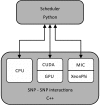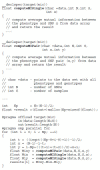Heterogeneous computing architecture for fast detection of SNP-SNP interactions
- PMID: 24964802
- PMCID: PMC4230497
- DOI: 10.1186/1471-2105-15-216
Heterogeneous computing architecture for fast detection of SNP-SNP interactions
Abstract
Background: The extent of data in a typical genome-wide association study (GWAS) poses considerable computational challenges to software tools for gene-gene interaction discovery. Exhaustive evaluation of all interactions among hundreds of thousands to millions of single nucleotide polymorphisms (SNPs) may require weeks or even months of computation. Massively parallel hardware within a modern Graphic Processing Unit (GPU) and Many Integrated Core (MIC) coprocessors can shorten the run time considerably. While the utility of GPU-based implementations in bioinformatics has been well studied, MIC architecture has been introduced only recently and may provide a number of comparative advantages that have yet to be explored and tested.
Results: We have developed a heterogeneous, GPU and Intel MIC-accelerated software module for SNP-SNP interaction discovery to replace the previously single-threaded computational core in the interactive web-based data exploration program SNPsyn. We report on differences between these two modern massively parallel architectures and their software environments. Their utility resulted in an order of magnitude shorter execution times when compared to the single-threaded CPU implementation. GPU implementation on a single Nvidia Tesla K20 runs twice as fast as that for the MIC architecture-based Xeon Phi P5110 coprocessor, but also requires considerably more programming effort.
Conclusions: General purpose GPUs are a mature platform with large amounts of computing power capable of tackling inherently parallel problems, but can prove demanding for the programmer. On the other hand the new MIC architecture, albeit lacking in performance reduces the programming effort and makes it up with a more general architecture suitable for a wider range of problems.
Figures





Similar articles
-
Review on GPU accelerated methods for genome-wide SNP-SNP interactions.Mol Genet Genomics. 2024 Dec 29;300(1):10. doi: 10.1007/s00438-024-02214-6. Mol Genet Genomics. 2024. PMID: 39738695 Review.
-
Real-world comparison of CPU and GPU implementations of SNPrank: a network analysis tool for GWAS.Bioinformatics. 2011 Jan 15;27(2):284-5. doi: 10.1093/bioinformatics/btq638. Epub 2010 Nov 25. Bioinformatics. 2011. PMID: 21115438 Free PMC article.
-
Efficient computation of motif discovery on Intel Many Integrated Core (MIC) Architecture.BMC Bioinformatics. 2018 Aug 13;19(Suppl 9):282. doi: 10.1186/s12859-018-2276-1. BMC Bioinformatics. 2018. PMID: 30367570 Free PMC article.
-
GWIS--model-free, fast and exhaustive search for epistatic interactions in case-control GWAS.BMC Genomics. 2013;14 Suppl 3(Suppl 3):S10. doi: 10.1186/1471-2164-14-S3-S10. Epub 2013 May 28. BMC Genomics. 2013. PMID: 23819779 Free PMC article.
-
Graphics processing units in bioinformatics, computational biology and systems biology.Brief Bioinform. 2017 Sep 1;18(5):870-885. doi: 10.1093/bib/bbw058. Brief Bioinform. 2017. PMID: 27402792 Free PMC article. Review.
Cited by
-
Combinations of genetic variants associated with bipolar disorder.PLoS One. 2017 Dec 21;12(12):e0189739. doi: 10.1371/journal.pone.0189739. eCollection 2017. PLoS One. 2017. PMID: 29267373 Free PMC article.
-
Combinations of Genetic Variants Occurring Exclusively in Patients.Comput Struct Biotechnol J. 2017 Mar 10;15:286-289. doi: 10.1016/j.csbj.2017.03.001. eCollection 2017. Comput Struct Biotechnol J. 2017. PMID: 28377798 Free PMC article. Review.
-
Review on GPU accelerated methods for genome-wide SNP-SNP interactions.Mol Genet Genomics. 2024 Dec 29;300(1):10. doi: 10.1007/s00438-024-02214-6. Mol Genet Genomics. 2024. PMID: 39738695 Review.
-
Protein-protein docking on hardware accelerators: comparison of GPU and MIC architectures.BMC Syst Biol. 2015;9 Suppl 1(Suppl 1):S6. doi: 10.1186/1752-0509-9-S1-S6. Epub 2015 Jan 21. BMC Syst Biol. 2015. PMID: 25707855 Free PMC article.
References
-
- Owens JD, Houston M, Luebke D, Green S, Stone JE, Phillips JC. Proceedings of the IEEE. New York, USA: IEEE; 2008. GPU computing; pp. 879–899.
-
- Nickolls J, Dally WJ. The GPU computing era. IEEE Micro. 2010;30(2):56–69.
Publication types
MeSH terms
LinkOut - more resources
Full Text Sources
Other Literature Sources

